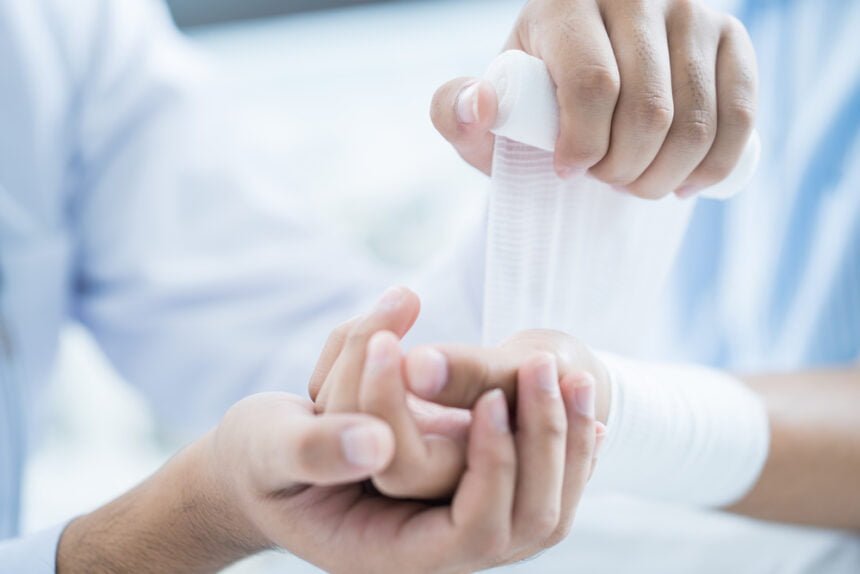Wounds are injuries that happen to internal or external body tissues. Some causes include accidents involving rough and sharp objects, falls, and car accidents. Every person has likely had an open wound at some point in life. If left untreated, a wound is exposed to harmful bacteria and may result in more severe health complications. While minor wounds can be treated at home, serious ones may require advanced wound care treatment with the help of a medical professional.
According to a recent study, the global wound care market is forecasted to grow at a compound annual growth rate (CAGR) of 4.1%, reaching USD$29.6 billion by 2030. As of 2021, the advanced wound dressing segment and chronic wound section accounted for 34.6% and 59.9% of the total market, respectively. The growing number of surgical cases, diabetic patients, and traffic accidents are some of the factors that have increased the demand for advanced wound care treatment.
Below are four advances in wound care treatment:
1. Cellular and tissue-based therapies and treatment
These are advanced wound therapies based on tissues and cells to accelerate wound healing and restore normal function in a clinically efficient way. One of the recent developments is the field of regenerative medicine. It uses different bioengineered techniques like stem cell treatments to help the body heal its own tissues.
Regenerative solutions include using tissue allograft products, such as injectable and topical suspensions, to support the regeneration of specific damaged tissues. Notably, this promotes your body’s natural healing ability. Ideally, stem cells or allograft products are injected directly into the damaged tissue, and their regenerative factors speed up tissue repair.
You might want to consider regenerative therapy, especially if you have a slow-healing wound. Various factors, such as age or health conditions, may cause your tissues to take too long to heal. For instance, diabetic people have slower immune system activation. Therefore, immune fighter cells responsible for wound healing don’t respond promptly, causing wounds to heal more slowly. Data shows that about 537 million people worldwide live with diabetes; by 2045, the number is expected to reach 783 million.
Another advanced tissue-based wound treatment is photobiomodulation wound therapy. It’s also referred to as low-level laser therapy (LLLT). It involves illuminating wounds with non-ionizing light-emitting diodes or lasers to induce stem cell differentiation and cell proliferation. The process enhances the speed and tensile strength of tissue formation and repair. Additionally, photobiomodulation alleviates pain or inflammation.
2. Advanced dressings
Some of the traditional wound dressing materials include hydro fibers, fabrics, sponges, cotton gauze, and acrylics. However, with extensive research and new wound understanding, advanced dressing materials that promote rapid wound healing have been developed. They include:
- Antimicrobial dressings: They contain antiseptic agents like medical-grade honey, silver, and povidone-iodine that can kill or prevent the growth of microorganisms in the wound or adjacent skin. Antimicrobial dressings can be in the form of gels, foams, creams, powders, ointments, pastes, or pads.
- Hydrocolloid dressings: They incorporate hydrophilic substances, such as polysaccharides, pectin, and gelatin, that absorb bacteria, dirt, and moisture in the wound. The adsorbent properties provide a strong viral barrier. Furthermore, hydrocolloid dressings can be used to promote autolytic debridement. It’s the breaking down of damaged tissue from the wound naturally through the use of the body’s enzymes and fluids. And since hydrocolloid dressings are moisture-retaining, they can soften the old tissue, making it easy to separate from the wound.
- Hydrogel dressings: Designed with high cooling and breathability capabilities to keep wounds moist. Besides providing excellent fluid handling, hydrogel dressings help cushion deep wounds and burns, preventing additional trauma.
- Alginate dressings: These are light nonwoven fibers made from seaweed or algae. They’re highly adsorbent, thus suitable for moderately to heavily exudating wounds. This property also minimizes bacterial infections promoting rapid granulation tissue formation.
It’s best to use advanced wound care solutions to promote faster and improved wound healing.
3. Negative pressure wound therapy (NPWT)
It’s also known as vacuum-assisted wound closure (VAC). It’s the process of removing fluids or infections from acute wounds like diabetic ulcers, pressure ulcers, or burns using negative pressure wound devices (NPWD). A specialized drape is used to seal off the wound, so a gentle suction pump can be attached for drainage. NPWD devices are usually used with other advanced wound care products, such as antimicrobial foams, for better wound care.
NPWT reduces inflammatory exudate, increases blood flow, removes bacteria preventing high-risk infections, and boosts the growth of new tissue. Generally, it allows the wound to heal more quickly. Plus, draining fluids can reduce the number of dressing changes required for a wound.
4. Skin substitutes
Skin substitutes are mainly used to help in wound coverage to promote faster healing. Skin substitutes can be temporary or permanent. Temporary substitutes are used for short-term wound closure and can be removed after three to four weeks. They are classified as:
- Natural substitutes: They’re derived from human cells and must be appropriately processed before use. They include human amnion, oasis wound matrix, and human allografts.
- Synthetic substitutes: They’re made from synthetic materials. Examples include Biobrane and TransCyte.
On the other hand, permanent substitutes are used to restore the full thickness of skin layers for chronic wounds. They include cultured epithelial autograft (CEA), alloderm, and Integra.
Generally, skin substitutes offer more flexibility and functionality to wound sites, accelerating healing. Moreover, they can be more cosmetically attractive.
Conclusion
Wound healing is a complex process that involves the activation of multiple cells and tissues. Above are some advances in wound care treatment aimed to facilitate improved and faster healing. Whether you have a minor or severe wound, it’s vital to seek immediate medical attention, so your doctor can recommend the best treatment option. Accessing medical care reduces the risks of developing further complications or infections.

